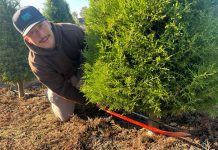Coyote Ridge, the hills east of U.S. 101 near Coyote Creek Golf Club, is once again ablaze with native wildflowers. Public tours are offered by docents from the Santa Clara County Open Space Authority (www.openspaceauthority.org ). I can tell you from experience that the hike is well worth the sight of the flowers and the breathtaking views of the Santa Clara Valley.
But the wildflowers weren’t always there. The story of how Coyote Ridge lost and then recovered its beauty is remarkable.
Much of Coyote Ridge is made of a rock called serpentine. It does not hold water well and produces very poor, rocky soil with low levels of plant nutrients. Not much can grow there, but the soil did foster the growth of a unique, hardy set of plants. These plants bloomed profusely and in glorious color in the spring.
The ridge was also home to the beautiful red, black and cream Bay checkerspot butterfly, which needs these flowers to reproduce and survive. The butterfly survives on nectar from the wildflowers, and its larvae feed almost exclusively on the California dwarf plantain and purple owls clover which grow there.
Then humans came to the Santa Clara Valley for jobs, and built homes in the lovely rural areas south of San Jose. They needed transportation from home to work, so highways were built to provide a convenient connection between the cities of Gilroy, Morgan Hill and San Jose. Eventually U.S. 101 was built all the way through the Coyote Valley, just at the foot of Coyote Ridge.
Soon the valley was filled with cars, which emit nitrogen gases. The nitrogen gases acted as fertilizer, eventually depositing up to 10 pounds per acre each year on the ridge. The nitrogen encouraged the growth of non-native and invasive species of plants, such as wild oats and Italian ryegrass. These invasive species crowded out the native plants, including the wildflowers that had previously grown in such profusion on the hillside. When the wildflowers disappeared, so did the Bay checkerspot butterfly.
The Bay checkerspot was added to the federal endangered species list, and environmentalists began scratching their heads trying to figure out how to restore the butterfly and native wildflowers to the ridge. Certainly, U.S. 101 was not going to be relocated or closed down, and people were not going to give up their cars.
Along came a simple, completely organic, old-fashioned solution: cows. Their preferred diet is the nitrogen-rich, non-native oats and grasses that now thrive on the ridge, squeezing out the native plants. Cattle are brought on the land to graze after the rainy season has begun, and remain until spring. Their dietary preferences have allowed the native plants to grow again, and the Bay checkerspot butterfly has returned. In fact, the butterfly is doing so well that, to establish new colonies, its larvae are carefully collected by researchers, operating under federal permits, and transplanted to other locations where serpentine exists and cattle are allowed to graze.
Coyote Ridge is once again home to some eye-popping spring flowers and butterflies, not to mention the other wildlife that call the ridge home: elk, bobcat, coyote, badger, eagles, meadowlarks, prairie falcons and kestrels, among others. Recent passage of the Santa Clara Valley Habitat Conservation Plan by Gilroy, Morgan Hill and San Jose, the County of Santa Clara, the Santa Clara County Transportation Authority and the Santa Clara Valley Water District will help ensure that Coyote Ridge is preserved for the foreseeable future.
A hike along the ridge is a magical experience that should not be missed. Because this is protected land, however, it is not open to the public except as part of a guided tour. Contact the Santa Clara County Open Space Authority about the tour schedule for 2013.










